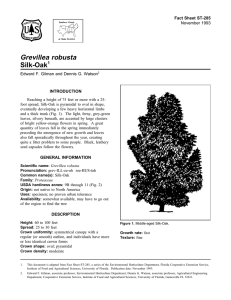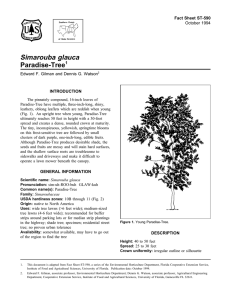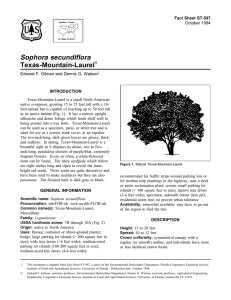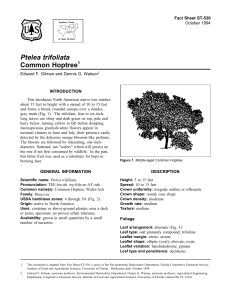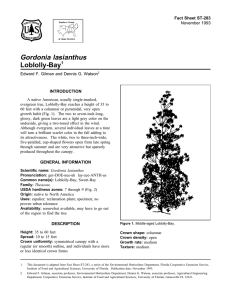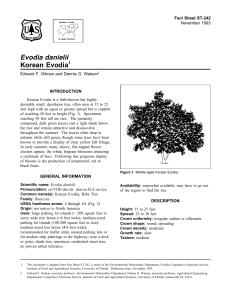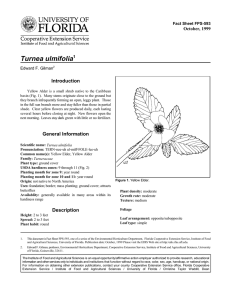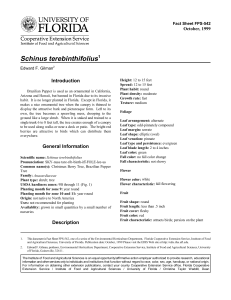Cupaniopsis anacardiopsis Carrotwood Fact Sheet ST-221 1
advertisement
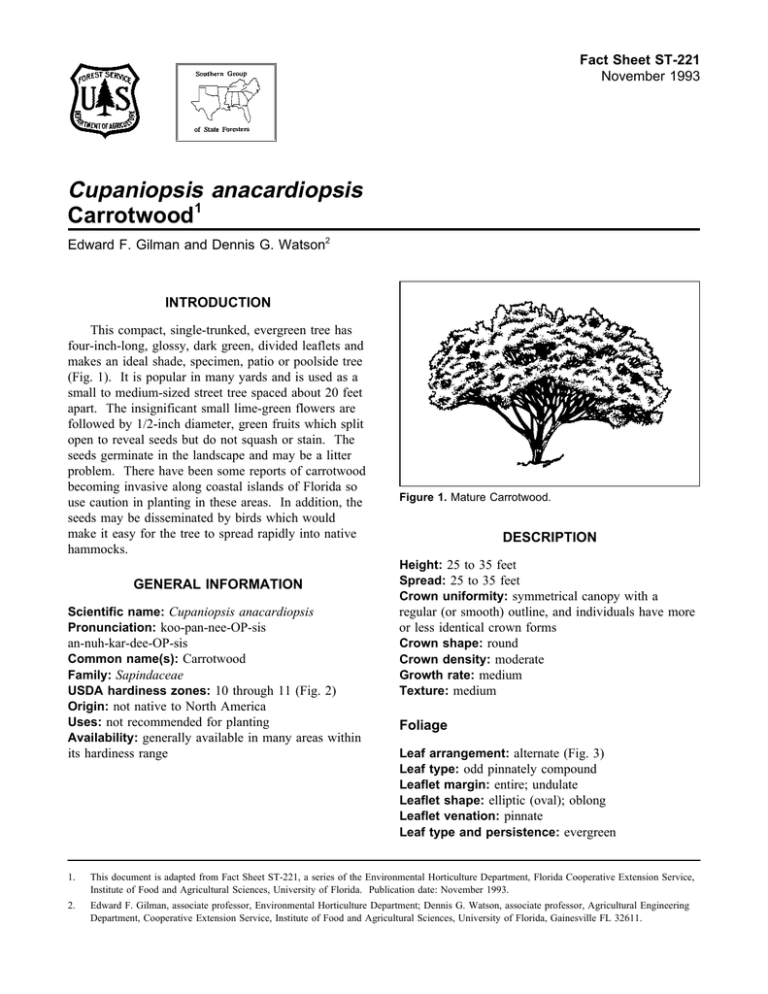
Fact Sheet ST-221 November 1993 Cupaniopsis anacardiopsis Carrotwood1 Edward F. Gilman and Dennis G. Watson2 INTRODUCTION This compact, single-trunked, evergreen tree has four-inch-long, glossy, dark green, divided leaflets and makes an ideal shade, specimen, patio or poolside tree (Fig. 1). It is popular in many yards and is used as a small to medium-sized street tree spaced about 20 feet apart. The insignificant small lime-green flowers are followed by 1/2-inch diameter, green fruits which split open to reveal seeds but do not squash or stain. The seeds germinate in the landscape and may be a litter problem. There have been some reports of carrotwood becoming invasive along coastal islands of Florida so use caution in planting in these areas. In addition, the seeds may be disseminated by birds which would make it easy for the tree to spread rapidly into native hammocks. GENERAL INFORMATION Scientific name: Cupaniopsis anacardiopsis Pronunciation: koo-pan-nee-OP-sis an-nuh-kar-dee-OP-sis Common name(s): Carrotwood Family: Sapindaceae USDA hardiness zones: 10 through 11 (Fig. 2) Origin: not native to North America Uses: not recommended for planting Availability: generally available in many areas within its hardiness range Figure 1. Mature Carrotwood. DESCRIPTION Height: 25 to 35 feet Spread: 25 to 35 feet Crown uniformity: symmetrical canopy with a regular (or smooth) outline, and individuals have more or less identical crown forms Crown shape: round Crown density: moderate Growth rate: medium Texture: medium Foliage Leaf arrangement: alternate (Fig. 3) Leaf type: odd pinnately compound Leaflet margin: entire; undulate Leaflet shape: elliptic (oval); oblong Leaflet venation: pinnate Leaf type and persistence: evergreen 1. This document is adapted from Fact Sheet ST-221, a series of the Environmental Horticulture Department, Florida Cooperative Extension Service, Institute of Food and Agricultural Sciences, University of Florida. Publication date: November 1993. 2. Edward F. Gilman, associate professor, Environmental Horticulture Department; Dennis G. Watson, associate professor, Agricultural Engineering Department, Cooperative Extension Service, Institute of Food and Agricultural Sciences, University of Florida, Gainesville FL 32611. Cupaniopsis anacardiopsis -- Carrotwood Page 2 Figure 2. Shaded area represents potential planting range. Leaflet blade length: 2 to 4 inches Leaf color: green Fall color: no fall color change Fall characteristic: not showy Flower Flower color: green Flower characteristics: inconspicuous and not showy; summer flowering Fruit Fruit Fruit Fruit Fruit Fruit Trunk and Branches Trunk/bark/branches: bark is thin and easily damaged from mechanical impact; grow mostly upright and will not droop; showy trunk; should be grown with a single leader; no thorns Pruning requirement: requires pruning to develop strong structure Breakage: resistant Current year twig color: brown Current year twig thickness: thick Culture shape: irregular; round length: .5 to 1 inch covering: fleshy color: green; orange characteristics: attracts birds; inconspicuous and not showy; fruit, twigs, or foliage cause significant litter Light requirement: tree grows in full sun Soil tolerances: clay; loam; sand; slightly alkaline; acidic; occasionally wet; well-drained Drought tolerance: high Aerosol salt tolerance: high Soil salt tolerance: good Other Roots: surface roots are usually not a problem Winter interest: tree has winter interest due to unusual form, nice persistent fruits, showy winter Cupaniopsis anacardiopsis -- Carrotwood Figure 3. Foliage of Carrotwood. trunk, or winter flowers Outstanding tree: not particularly outstanding Invasive potential: No entries found. Verticillium wilt susceptibility: susceptible Pest resistance: no pests are normally seen on the tree USE AND MANAGEMENT Carrotwood tolerates poor, dry or wet soils, full sun, and hot, salty winds. It is truly a durable, urbantolerant tree, able to grow even in confined planting pits in downtown sidewalks. Perhaps it is best used in these areas. It is deep-rooting on well-drained soils and will tolerate drought. Selected, upright branches in the crown can be removed to allow for more light penetration and better turf growth under the crown. If not, the dense canopy will shade out all but the most shade-tolerant plants. The wood is bright apricotcolored in cross-section, and resists breakage because it is hard. If you cut one down, save the wood. Wood-workers enjoy turning it on a lathe and making spindles and bowls. Propagation is by seed. Pests and Diseases No pests or diseases are of major concern. Warning: Use with caution since the tree has become invasive in south Florida. Commonly used as a street tree in southern California. Page 3
